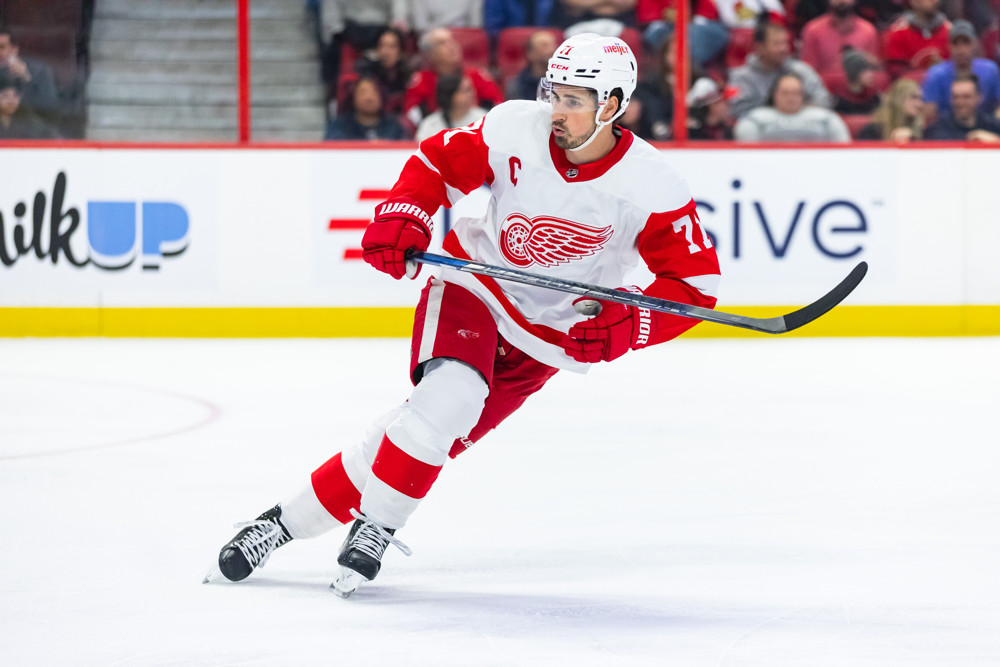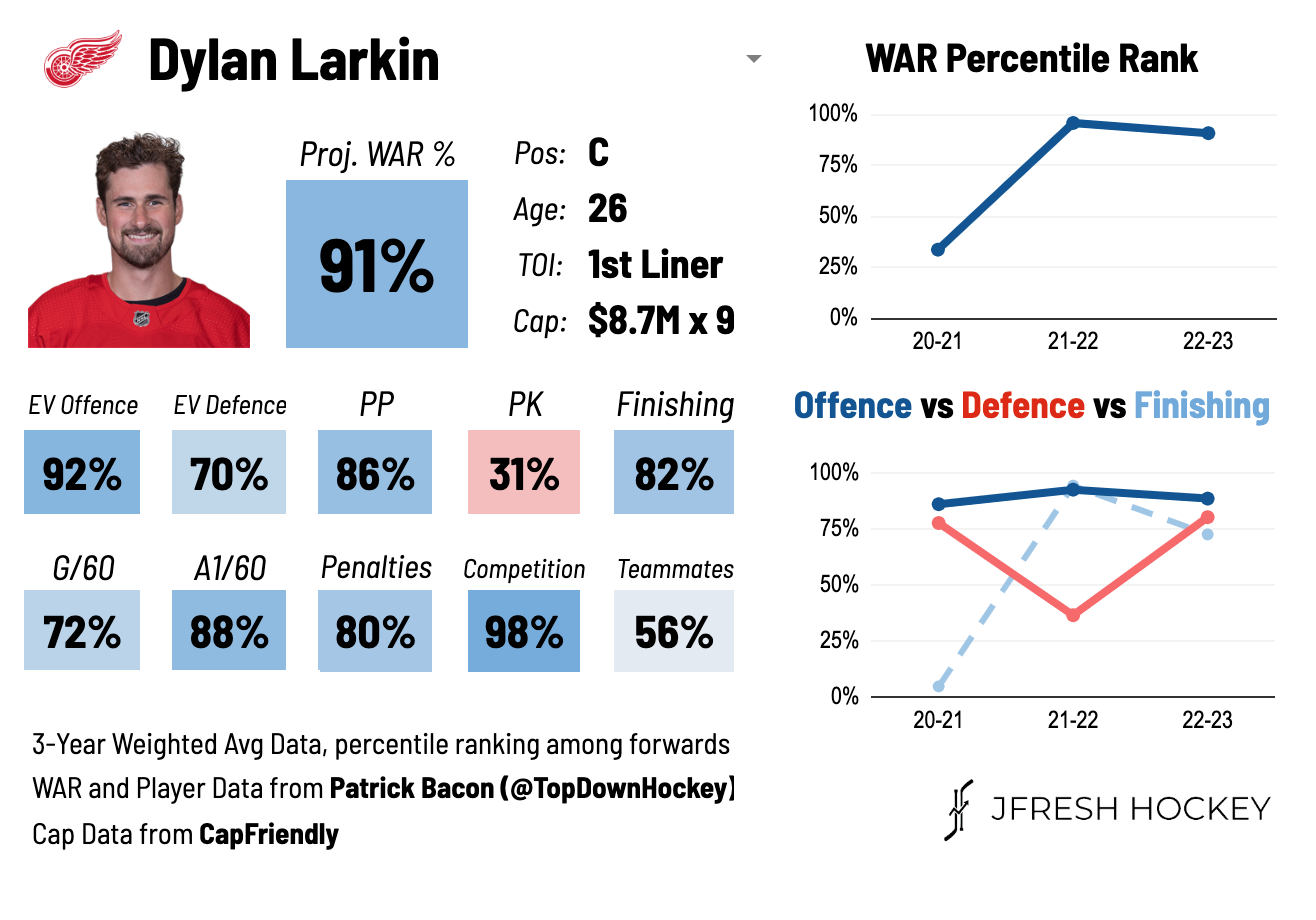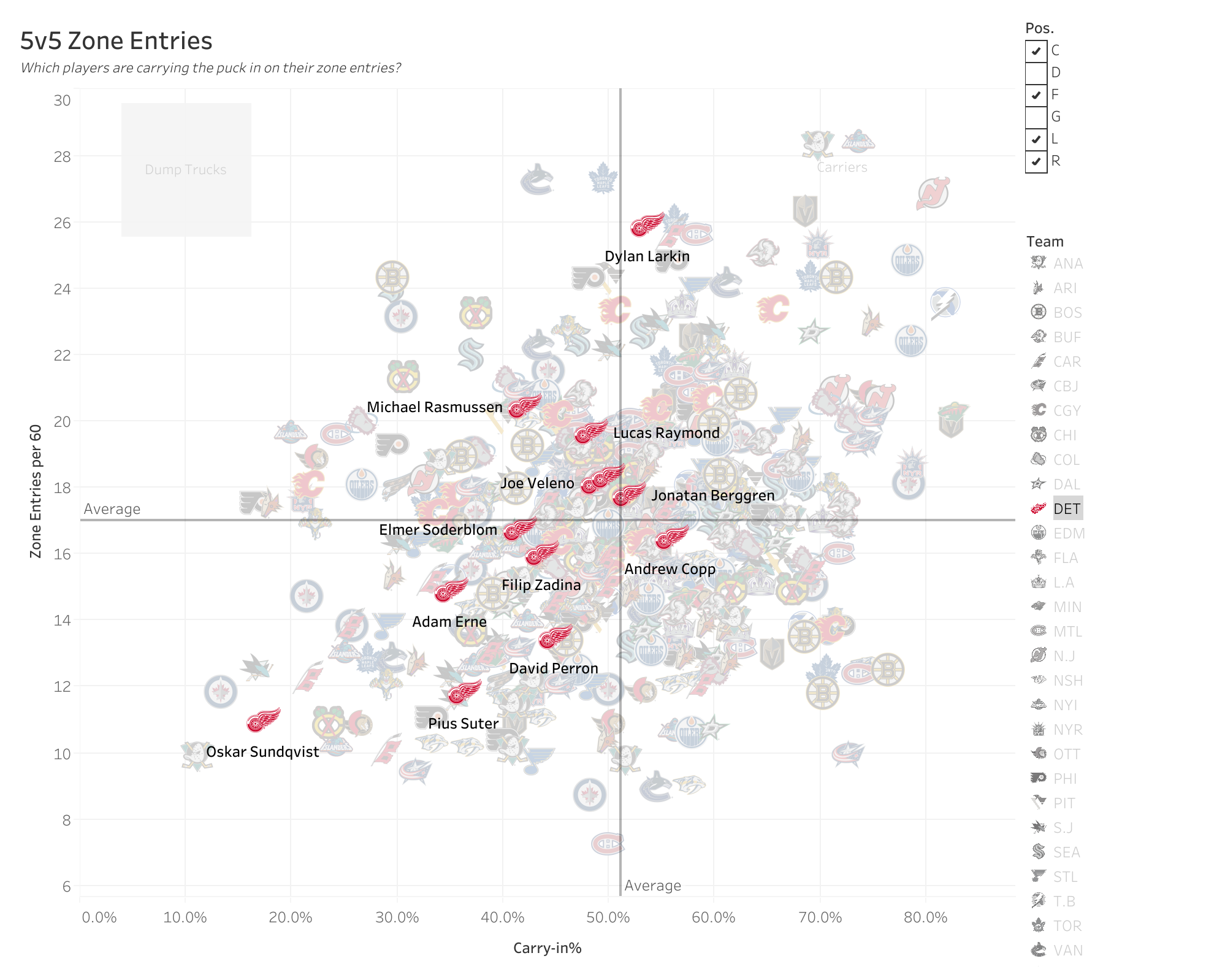
Amdist the choas of the 2023 NHL trade deadline, the Detroit Red Wings made a big move to keep one of their own. Not just one of their own, their captain, the guy responsible for steering the ship on the player side of things.
Dylan Larkin does a lot well, he's a dynamic presence in the Red Wings lineup, and he was rewarded for that with an eight-year, $69.6 million contract extension that will carry an $8.7 million cap hit per season.
One of the common historical adages used to describe players, especially forwards, in hockey scouting reports is to indicate they play a "200-foot game." This cliche is reserved for those forwards that usually post strong defensive results in addition to their contributions at the offensive end of the ice. If you're looking for a utopian version of this player, think Patrice Bergeron.
While it's mostly fodder for draft rankings, we can attach some discernible behaviors to this. We can attach the on-ice results, too. As always, these elements usually go hand-in-hand, and Larkin is no exception to that rule. Simply put, Larkin is a player that, as the adage suggests, covers a large portion of the ice surface. As a result, he grades out offensive and defensively in high percentiles relative to the rest of the leagues forwards.
For a glimpse at this impacts results, let's incorporate a visualization of his results courtesy of JFresh Hockey's play cards.

As you can see, aside from last season, Larkin's offense and defense are usually high impact and totally in tandem with one another.
This ties right back into the eye test. Larkin is what I often call the "FIFO" forward. That stands for first in, first out. Larkin is the first forward back into the defensive zone to support his defensive partners and make an impact in preventing shots and scoring chances, but he's simultaneously the first forward in on attack, pressing the opposing defense and pushing the pace offensively.
That, in essence, is the spirit of playing a 200-foot game. Larkin's mobility, speed, and on-ice awareness enable him to make the right reads to get early jumps on plays in all phases of the game. I am going to really lean on Larkin's skating in these videos, as his quick feet and overall mobility allow him to seemingly be in in multiple places at once.
These situations put Larkin in a position to have a massive impact in the world of offensive zone entries. As an active participant on the defensive side, Larkin puts himself in a lot of puck battle situations that enable him to skate away with possession or be the recipient of an emergency pass from his defensive partner. Those possessions are numerous and they're leading to a high number of zone entries on the attack. Consider the following data from my colleague Corey Snajder's All Three Zone's project that shows just how far removed Larkin is from his peers in the world of zone entries this season.

There are only seven forwards in the league with a higher average of zone entries per 60 minutes of even-strength hockey than Larkin. That is impressive company to be in and a testament to his ability to impact the game with his puck possession abilities.
I wanted to post a clip of what I mean by the first in, first out concept and what it looks like on tape. This clip covers Larkin stepping onto the ice during a line change and immediately attacking the center of the Penguins defensive unit. Later, as the shift progresses, Larkin steps in for a pinching defenseman and assumes their role perfectly as the play transitions back to the defensive zone.
There is a lot of skating involved in these clips. Larkin is covering a lot of ice and as you can see, he's the first forward in on the attack, and the first one out of the zone to cover defensively. This attention to both ends and willingness to be the one to do the extra work sets him up to have success both offensively and defensively as we saw in the data sets above. Larkin's high level of effectiveness in each zone is distinctly tied to the work he's doing in those zones.
We can see this again in the next clip. In a similar situation to what we saw above, the defense pinches again in this clip. Larkin recognizes the situation and skates back to play the role of defenseman in the breakout. What I find interesting in this clip is not only does Larkin play the role of defenseman and help out on the backend, but he also immediately jumps out of that role and back to being a forward again so fast, he receives the first pass on the breakout after he set the entire thing up to begin with. Look at how much ice surface covers here, and the various amount of responsibilities Larkin takes in the process.
Again, this is why Larkin is posting positive results offensively and defensively. He is, truly, a player that is covering all 200-feet of the ice. He's helping produce results offensively and defensively and we can identify these moments clearly on the video.
Larkin is always looking to see where he can help impact his defensive partners. In the next clip, he sort of abandons his typical post of responsibility to sink low and help pinch off a Maple Leafs cycle. As a result of his back pressure, he's able to get back into the play quickly to be first on the attack in the offensive zone. The result is a goal.
This is a huge impact for the Red Wings because it's such a big help to have a forward as invested in the defensive zone as Larkin is in these clips. Again, let's go back and think of our adage I mentioned earlier. Larkin is going from end-to-end in most of these instances and covering a huge amount of ice in the process.
So often, you see adequate to poor forwards playing as passengers in the defensive zone. They're just gliding around, taking up space, but not actually doing anything in the process. This is not a trait of Larkin's.
As we can see in the next clip, he proactively identifies areas of concern on the defensive side of the ice and seeks to quell them as quickly as he can. He prevents a scoring chance in the slot in the next clip, and once again, immediately turns it into offense.
You can see this same behavior in the next clip. This time, instead of making his play in the slot area, Larkin's is hanging higher in the offensive zone. He recognizes where the play is heading, makes a beeline for it, and immediately flips the play into an offensive chance.
Again, be thinking about how these circumstances impact both offensive and defensive results as you watch the clips. We know Larkin has had a high impact in these areas and these clips help explain why that is the case.
I mentioned earlier the concept of being the first forward into the defensive zone to support the defensemen, but that isn't always possible. I wanted to post a video of an alternate situation where Larkin gets stuck in the offensive zone and is actually the last player back to help as a result.
As you can see from the film, it doesn't change his approach at all. When the puck is in the defensive zone, Larkin is in attack mode. Although he's the last player back, he immediately makes a play on the puck and dispossesses a forward. He has only been in the defensive zone for seconds when this opportunity presents itself. He's in and out extremely fast here.
Again, just like in the other clips, Larkin starts and finishes this play. He begins it with a defensive zone win, and ends it with a one-timer opportunity.
This contract is an amazing deal for Detroit for multiple reasons, but chief among them is the huge area of influence Larkin has on the ice. He is active defensively, an extreme threat offensively, and elevates the play of those around him as a result of these habits.
As his career progresses with Detroit, it's not unreasonable to assume that his defensive impacts can continue to grow and make this contract even higher in value.































